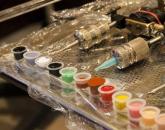Methods for connecting the Internet via optical fiber by the operator. Fiber optic internet connection
Recently, many people have become interested fiber optic internet. Most people know that this technology involves at a fairly high speed. Not so long ago, such speeds seemed fantastic to many, although the technology began to develop almost a century ago - back in the thirties of the last century. That is why it is worth considering what fiber optic Internet is and why this technology is out of competition.
A bit of history
The first attempts to transmit data over a distance by means of light and transparent materials were made as early as 1934. Norman French proposed to convert the voice into light signals, which would then be transmitted through glass rods. A few years later, Swiss physicist Jean Daniel Colladon conducted an experiment with the transmission of light through a "parabolic liquid flow", that is, water. Optical fiber in modern form appeared in 1954. The authorship belongs to two physicists from England - Harold Hopkins and Narinder Singh Kapani, as well as a researcher from Holland - Abraham Van Heel. Since they simultaneously announced their invention, all three of them were considered the founders of this technology. And two years later, the name was coined - optical fiber.
The loss of light in the former was very large. In the late fifties, Lawrence Curtins was able to reduce them. And when laser technology was discovered in 1962, optical fiber had another chance to exist.

Peculiarities
Now we can return to the present. On this moment fiber optic internet is characterized by incredibly high data transfer speeds. This is not at all surprising. The carrier of information in this case is light, and its speed of movement is the highest in the Universe. Such a property must have found application, and it is. In a simplified sense, it is transmitted like this: if the light is on, then it is 1, and not - then 0. A fiber-optic Internet cable transmits alternating zeros and ones at such a speed that it is simply impossible to see with the naked eye. The transmitter is responsible for the change of pulses, which converts electrical signals into light. And at the other end of the cable, a receiver is usually placed that performs the inverse conversion.
Fiber optic Internet is characterized by huge speeds, which is its main advantage. Another plus is the ability to work over long distances. for the Internet, it is laid along the bottom of the ocean; it can stretch across the entire mainland. Naturally, the fitters who lay it have a very difficult time: they install signal amplifiers at the junctions, which cost several hundred times more than the wire itself, but for the technology as a whole, such investments cannot be called excessively large.

Additional properties
This method is also used in other areas. By means of the thinnest wiring, it is possible to provide illumination during complex operations on the human heart or brain. Light systems are also gaining popularity, which are based on the same optical fiber, but instead of information, they bring sunlight into the house, which they catch from the street.
In addition to the speed and long range of information transmission, this technology has one more plus - it is almost impossible to intercept information when using it.
Fiber Internet: disadvantages
There is only one minus - too expensive equipment and tools for installation. The cable itself is not that expensive compared to transmitters, receivers and signal amplifiers. The soldering of wires is carried out by means of special inverters, which can cost as much as very expensive cars.

Characteristics
Fiber optic Internet is characterized by high speed, as described earlier. For home use, its minimum rate is 10 Mb / s. Physically, no home cable is capable of supporting such a speed. It is best to use such a connection if you have a home server, or if you have not one, but several computers that constantly need access to the Internet. Separating the fiber optic cable requires the installation of a special router. It can be intended for home use or for trunk channels. Fiber optic Internet will work with special routers that were produced no earlier than 2010. Their model range is quite extensive, so for each user you can choose the best option.

Fiber optic internet (Rostelecom)
Rostelecom has been providing citizens with access to world wide web using ADSL technology, which involves signal transmission over a regular telephone line. Now the operator has begun to actively introduce completely new methods. Now fiber-optic Internet is being actively introduced using FTTB technology (optics to the building). With its help, it is possible to significantly improve the quality of services provided to the population, the reliability of the connection and its maximum speed, which can reach 100 megabits per second. When the network passes complete modernization, each resident of the selected locality will be able to use the full range of services. For example, it will be possible to watch digital television, which is many times superior to cable and satellite in terms of quality and capabilities. Such a solution is a high quality video, image and sound, as well as a convenient interactive menu, ease of use and other advantages.

conclusions
At the moment, fiber optic Internet is an advanced solution to the problem of data transmission. Only cryptonetworks that are still at the design stage are capable of surpassing it in speed, and it is not yet clear when their development will begin. That is why it is worth considering how to connect fiber optic Internet.
Let's see what fiber optic internet gives us, how to connect it and how to set it up.

How it looks in the conditions of the apartment can be seen in the picture below.
7. Rostelecom does not have a local network ("since its organization is contrary to the legislation of the Russian Federation." - Rostelecom), but there are so-called "" based on torrent clients. The horror is blue, in my opinion. One of the applications brought me the Amigo browser for 333 megabytes, Vkontakte and Odnoklassniki. Another just hung after the firewall refused to give it free rein on my computer.
8. In the event of a power outage, you will not be able to call an electrician by phone - the phone will stop working, as it will also depend on electricity. Despite the fact that everyone has mobile phones, it’s not so scary, but someone else connects uninterruptible power.
9. In case of a malfunction, first check the power supply of the terminal, reboot the equipment, then connect it directly with a cable and, if this does not help, dial the support phone. It is possible that you will be asked to report the status of the indicators on the terminal panel. I have given the support phone number above.
So or something like this, and there is a connection to the network via fiber optic.
The initial basic setup process was described in a D-Link post.
If you are trying to figure out what fiber is, then you definitely hit the right place!
Many Internet users use fiber optic wire to connect to the Internet.
However, practically no one knows what an optical fiber is, what it is and how it transmits information?
optical fiber is the world's fastest way to transfer data over the Internet.
An optical cable has a special structure: it consists of small thin wires that are separated from each other by a special coating.
Each wire transmits light, and the light, in turn, transmits data over the network.
Let's take a closer look at how to connect the Internet and configure its work yourself.
First of all, make sure you have fiber optics connected to your home. Next, order the network connection service.
The terminal is also equipped with two additional jacks for connecting an analog home phone and a few more sockets are needed to connect television from Rostelecom.
After connecting all the components, you should check the Internet connections on your computer:
- Go to command prompt as administrator. To do this, right-click the manipulator on the Windows icon, select the required item;

High speed internet, digital TV, mobile connection possible thanks to thin glass threads stretching along seabed between continents. If not for fiber optics, you would hardly be reading these lines.
The fundamental foundations of this technology are described in the middleXIXcentury. Then they tried to use water as a signal conductor - to no avail. Suitable materials for the realization of a bold idea were developed only after more than a hundred years.
Conductor for light
In a conventional wire, the signal is transmitted through a copper core. Information is carried by a stream of electrons - electricity. Data is transmitted encrypted in binary code. If the impulse passes - this means one, if it does not pass - zero.
In a fiber-optic communication line, the encoding principle is the same, but the information is carried by photons or light waves, more precisely, both at the same time. Scientists argued about the nature of light for so long that they ended up consolidating disparate theories. But one does not need to understand quantum wave dualism to understand how light is used to transmit information in telecommunications networks.
It is enough to understand how to make light flow through wires for kilometers.
The first thing that comes to mind is mirrors. Make a metal tube and coat the inside with a smooth layer, such as silver.
Light entering on one side will bounce off the walls until it reaches the exit on the other side. Not a bad idea, but it won't work.
Firstly, the manufacture of such a tube of the desired length is an extremely difficult and, therefore, expensive task.
Secondly, the reflection coefficient of silver is 99%, that is, the light that enters the tube will lose energy and will completely go out after 100 reflections.
Much better to do without mirrors. How to do this, the foundations of geometric optics, laid down in the 19th century, will prompt.
The basic idea is easy to demonstrate using an aquarium as an example. A beam of light from a source under water passes through the boundary of water and air - two media with different optical properties - and partially changes the direction of movement, and is partially reflected from the boundary of the two media as from a mirror.
If the angle of incidence of the beam is reduced, at a certain moment the light will stop coming out of the water at all and will be reflected completely, by 100%. The boundary of two environments works better than any mirror.

As it turned out, to create such a border, water is not needed. Any two materials that transmit light differently - having different refractive indices - will do. Even a difference of 1% is enough to create a light guide.
glass wires
In lamps and toys, light guides are made of plastics, but more expensive and more transparent materials are needed to obtain an optical fiber suitable for communication.
Scientists have adapted quartz glass for this purpose. The fiber preform core is most often made from pure silicon dioxide. The outer layer is also made of quartz, but with an admixture of boron or germanium to reduce the refractive index.

Previously, in order to obtain such a blank, they simply inserted two glass tubes into each other, but today it is more often done differently. Hollow tubes of pure quartz are filled with a mixture of gases with a high content of germanium and slowly heated until the germanium is deposited in a uniform layer on the inner surface.
After the quartz glass has grown enough thick layer germanium oxide, the pipe is heated until softened and pulled out until the cavity inside collapses.
Thus, a rod with a diameter of 1 to 10 centimeters and a length of approximately 1 meter is obtained, already containing quartz with the addition of germanium in the core, which has an increased refractive index and a shell of pure quartz around.
Such a blank is delivered to the top of a tower up to several tens of meters high. There, the lower part of the workpiece is again heated to one and a half thousand degrees - almost to the melting point, and the thinnest thread is pulled out of it. On the way down, the glass cools down and is dipped into a bath of polymer, which forms a protective layer on the surface of the quartz. With this method, up to 100 km of fiberglass is obtained from one blank. At the base of the tower, the cooled fiber is wound onto a reel.
Yes, it is wound: oddly enough, quartz fiber bends easily.
The resulting fibers are collected in bundles of several pieces and sealed in polyethylene. Cables are then woven from these bundles.

Each cable can have from two or three to several hundred light guides. Outside, for strength, they are braided with a polymer thread and receive another protective sheath made of polyethylene.
Advantages and disadvantages of optical fiber
All these difficulties are justified because light is the fastest thing in the universe.
Due to this property of light, optical fiber has an unsurpassed information capacity. A twisted pair, like a telephone line, or a coaxial cable, a conductor with a shield, passes 100 megabits per second.
Most common for computer networks An eight-core, 4-twisted-pair cable transmits up to 1000 megabits per second. Optical fiber in one core - three times more, up to 3000 megabits per second, and with the help of various experimental tricks this threshold can also be overcome.
In addition, optical fiber is much lighter than copper. At 9 microns thick—thinner than a human hair—a 100 km long filament of quartz weighs about 15 g.
Almost all modern trunk data transmission lines are laid from fiber optic cables. They link continents, countries and data centers.
IN major cities"optics" is also used when connecting apartment buildings to the global network, but the fiber is laid between the provider and the house, and the usual twisted pair is bred for apartments.
With this connection scheme maximum speed network access for the subscriber still does not exceed 100 Mbps. For comparison, by running an optical cable directly into the apartment, you can get a channel of 1 Gb / s, and yet the consumer rarely encounters fiber-optic Internet.
It's not just that optical fiber is expensive to manufacture. Laying the cable is just the beginning. Signals traveling along a communication line accumulate errors over distance and eventually fade out altogether. For a twisted pair, this happens after 1 km, for a coaxial cable, after about 5 km. After the signal has to be restored and amplified - regenerated.
Fiber optics have a regeneration distance many times longer, but no matter how pure quartz glass is, impurities remain in it, for example, millionths of a percent of water.
The length of the fiber can be hundreds of thousands of kilometers, but after 100–200 km, the attenuation of the optical signal still manifests itself.
Therefore, intermediate amplifiers are installed on fiber-optic communication lines, which restore the amplitude of the optical signal, and regenerators that remove interference. Such equipment is much more expensive than amplifiers on traditional communication lines, and requires qualified service.
But most importantly, at the moment, gigabit communication channels are little in demand by ordinary people. It is possible that with the advent of smart homes, wearable computers, and the spread of streaming video in ultra-high resolution, the need for them will increase, but for now, the speed provided by twisted pair is enough for the average consumer.
Even without coming into direct contact with this technology, each of us enjoys its benefits. Stability of connection, low signal delay to the most remote servers and high speed of receiving a response from them, the ability to withdraw money from any ATM and make a call to any country in the world - all this is the merit of fiber, and it has no competitors in the project.
The rapid development of communication technologies has led to the spread of broadband Internet. If until recently people were happy with the speed of 128-256 kbit / s, today you will not surprise anyone even with a hundred megabits. Optical fiber from Rostelecom is a great opportunity to conduct an apartment or a private house Internet channel with a decent speed. The optical networks of this provider have penetrated even into small towns allowing subscribers to enjoy high-quality Internet services and interactive television.
For a long time, Rostelecom used telephone lines using ADSL technology in its activities. It provided access speeds up to 24 Mbps, depending on the performance of the line and its technical condition. The longer and worse the line, the more attenuation in it and the more losses. At the maximum length, the access speed was up to 2-3 Mbps. But if it was possible to set a solid thrashing of Rostelecom, telephone operators "licked" the line up to a speed of 4-5 Mbps.
The main advantage of ADSL is that this technology uses the good old telephone lines. And it is much easier to put a telephone in a house or apartment - telephone cables are laid in almost all streets. But ADSL also has disadvantages:
- Limited line length - we have already written about this.
- Communication break once a day - approximately at the same time (technological feature of ADSL).
- Dependence on attenuation in the line - the more twists in the wires and the worse the quality of their connection in telephone cabinets, the greater the attenuation and the lower the speed.
- The dependence of the incoming speed on the busyness of the outgoing channel - for example, if the torrent client began to work intensively for distribution, page loading begins to suffer. The ping also goes up a lot.
It started to rain - there may be problems on the line if somewhere water begins to flood the connections. In other words, ADSL has many disadvantages.
Features and Benefits of Fiber Optic
An optical line is a channel in which data is transmitted over a thin fiber optic cable. The diameter of the working core is measured in micrometers. Information is transmitted by modulating the light flux. This flow moves inside the cable with virtually no attenuation. The core is made of silicon dioxide and is characterized by minimal attenuation.
Light and thin optical fiber is capable of transmitting gigantic amounts of information. And if several dozen cores are combined in one cable, then throughput grows to incredible proportions. Compare for yourself - only one phone conversation, with high-frequency compaction - several tens or hundreds of conversations, and an optical cable with one core can connect several thousand and even tens of thousands of subscribers.
Optical fiber is characterized by its high cost. For its connection and soldering, expensive equipment is required. It is difficult to lay it, it is difficult to connect single subscribers through it. Traditional expensive optics have been replaced by PON (or GPON) optical networks based on passive optical fiber. It is characterized by low cost and ease of connection, which provided fast development technologies. Thanks to GPON, it is possible to carry out high speed internet to each house or apartment separately optical cable.
Advantages of optics for the subscriber:
- High speed access to network resources - in some regions, Rostelecom "accelerates" home Internet up to 250 Mbps, this is a very decent indicator. In most regions, the maximum speed is 100 Mbps. In remote northern areas, the speed is limited to lower values.
- High speed for the return of information - fiber optic Internet will provide not only fast downloading of files, but also their fast sending.
- Link stability - forget about regular disconnections. In addition, the fiber is not at all afraid of heat and cold, as well as precipitation.
- Fast connection to the network - on ADSL, it takes about a minute to establish a connection after turning on the modem. An optical fiber connection takes a few seconds.
- Digital TV connectivity with high picture quality - enjoy TV in HD quality.
Optical fiber from Rostelecom will allow you to connect a whole bunch of home devices to the Internet, and they will not interfere with each other.
Another advantage of optics is a more reasonable compromise between subscription fee and speed. In some regions, the difference can reach 10 times. For example, 3 Mbps for 550 rubles via ADSL and 30 Mbps for the same 550 rubles via optical fiber. And by connecting several services at once as part of a package tariff plan, you will receive a discount on the total subscription fee.
Disadvantages of fiber
The main disadvantage of optical fiber is its small geography of development. Particularly affected private sector, where the majority of subscribers are connected via telephone lines. Subscribers can wait for years to see if fiber optics from Rostelecom and, in general, from any provider will reach them. The same telephone is much easier to lay - there are cabinets and wells almost everywhere. But connecting fiber from Rostelecom is not always possible.
The cost of wiring fiber optics by Rostelecom to an apartment may turn out to be low or even zero - if the trunk has reached a multi-storey building, then it takes several hours to separate the optics from apartment to apartment. But the price of connection in the private sector can be high - up to several thousand or tens of thousands of rubles. But it's really worth it, trust me.
Basic wiring diagrams
There are two main schemes for connecting the Internet from Rostelecom via fiber. The first is called FTTx - an optical cable reaches a multi-storey building, then subscribers are connected by a cable used for laying local networks(twisted pair). This scheme is highly reliable, because this cable provides connection speeds up to 1 Gbps.
The second scheme is xPON technology, when fiber optic cable for the Internet starts directly in the apartment. To do this, a flexible (so-called pigtail) is soldered to a rigid optical cable, then the flexible cable is connected to a media converter. A twisted pair cable goes from the media converter to a computer or router). There are also routers with PON support on sale, here a media converter is not needed (at the same time it will not take up an extra outlet).
Popular
- Confectionery business plan with calculations - how to open a confectionery business plan for a home confectionery sample with calculations
- Business plan for a tire shop What you need for a truck tire fitting
- How to open a taxi service: the nuances of doing business
- The most promising business ideas from America
- How to open a .DSF file? How to open DSF? Sponsor Information
- Features of the presentation of tourism services on the example of the travel agency "Hot Tours" (g
- Ideas for starting a business in the USA Idea #1
- Urgent order of a gazelle cargo taxi24
- How much does a YouTube channel earn?
- Features and organization of the case




